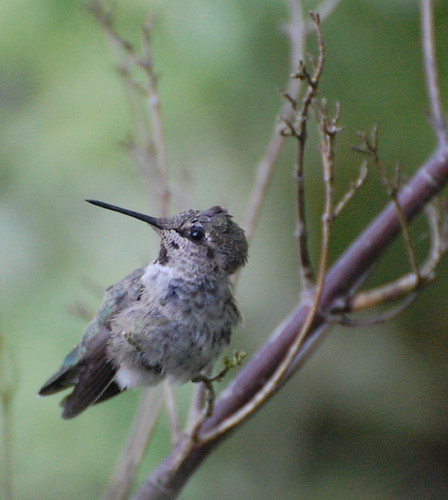For the past several weeks, I've been bombarded with news stories that have almost...ALMOST...brewed enough ire in my soul to come pouring out through my pen. Donald Trump. Kim Davis. Sandra Bland. Planned Parenthood videos. Maybe I've just...had it. Maybe there's nothing more this god-forsaken country can churn out that shocks or horrifies me enough to comment on.
I've been riding this political roller-coaster since 2003. Maybe there simply is no drop death-defying enough to entice a screech--or even a startled gasp--from my throat. We've already gone over the edge...where else is there to go?
And then, this morning, there was this. It popped up innocently on my Facebook news feed, as the Peterson Field Guide page is among those I have "liked."
It got no notice at all from any of the liberal Facebook entities ...not Mother Jones, nor Daily Kos, nor Salon, nor Occupy Democrats. No outcry from PETA, nor the SPCA, nor the IAPF. In case you haven't clicked on the link and read the story, I'm quoting it in its entirety here:
"The Moustached Kingfisher is an elusive bird—the cartoonish species had not been seen in the wild for decades, and until earlier this month, it had never been photographed. But two weeks ago a group of researchers led by individuals from the American Museum of Natural History (AMNH) happened upon one while surveying endemic wildlife in the mossy jungles of Guadalcanal, the biggest isle in the Solomon Island chain, and snapped some winning photos of the bright blue bird."AMNH biologist Chris Filardi and his team were traipsing through the dense forest when they heard what they thought was the call of a large kingfisher. Moments later, one of the surveyors spotted something moving in a nearby thicket: A blue-and-gold bird flourished its crest for a moment, before vanishing in a blur of color, Filardi wrote in his blog. "A methodical tail pumping behavior that caught my eye" helped him recognize it as a male Moustached Kingfisher—a bird he'd sought for more than 20 years."There have been very few sightings of Moustached Kingfishers to date, and none of them have been male. Prior to this discovery, the only real sources of information on the species were three female specimens spotted in the 1920s and 1950s. That doesn’t mean the birds are particularly uncommon—they just prefer a very specific, and hidden, habitat. Moustached Kingfishers tend to roost in tall patches of closed-canopy forest and nest in holes in the ground. Their anonymity may also come from the fact that very few ornithologists have explored Guadalcanal over the last century. The stately birds tend to be crepuscular—only active at dusk and dawn—making them even harder to spot and giving them their ghost-like reputation.“Initially it was a surreal, childlike sense of a mythical beast come to life, Filardi says."In the days following the sighting, Filardi and his team eavesdropped on several more kingfisher calls. They were finally able to catch one in a mist net—“a gorgeous, strong, and raucous” male, Filardi says. The researchers got to work right away photographing and filming the bird’s behavior. Ultimately, with the blessing of the local community, the team decided to euthanize the bird so they could bring the specimen back with them for further study, in hopes of answering questions about lineage and evolution of this cryptic species."Editor’s Note: This story has been updated to clarify that the bird was euthanized and the specimen collected. Paul Sweet, collection manager for the Department of Ornithology at the American Museum of Natural History and one of the researchers on the team, told Audubon that they assessed the state of the population and the state of the habitat, and concluded it was substantial and healthy enough that taking the specimen—the only male ever observed by science—would not affect the population’s success."
An American scientist. Obviously one with the economic and academic chops to mount a major research expedition. Traipsing through the dense jungles, among the fantastical array of flora and fauna, enough to thrill the heart of any researcher worth his salt, he happens upon the rarest of birds, hardly seen and never photographed. He hears its telltale calls and noises, catches a quick glimpse of it flitting away... Ah! A story that calls to mind the adventures of Stanley and Livingston, or Jane Goodall.
But it quickly becomes obvious that this guy is no Jane Goodall. "The team" first contrives to CAPTURE the bird... ( The red flag in my head immediately goes up.). WTF? Why did you have to do that? Not stealthy or patient enough to wait for it and observe it undisturbed in its natural habitat?
As if that weren't bad enough, the real shocker comes at the end of the article, where the author mentions, almost as an aside, that the scientists eventually EUTHANIZED this lovely, wild creature ...so they could take it back to the lab and study it further. (No more red flags in my head for this one...my head just explodes.)
I stare at the screen. What? WHAT? Am I really reading an article on the Audubon Society website that has just reported the killing of a rare bird as if it were as commonplace and perfunctory as "collecting a specimen"?
Just like human beings. "Ooh! pretty! I've never seen one of those! Gotta HAVE it! And if I KILL it, It can be mine forever and I can show it off to all my friends! Won't they be jealous??!?"
DO NOT try to tell me that this is standard scientific procedure. Yes, I know Audubon himself routinely killed birds in order to study them, and is still considered one of the greatest naturalists of all time. This has always seemed creepy and morbid to me, yet I can cut Audubon some slack, since he did not possess any of the technological advances that are at the disposal of today's scientists. Today's researchers can get their hands on tools that John Audubon would habe thought miraculous...or devil-possessed.
But we HAVE those things now. We HAVE digital photography, and "bird-cams", and powerful microscopes and chemical testing equipment. We don't NEED to kill an animal in order to study it.
So I can only conclude that this was yet another (poorly disguised) instance of trophy-taking; no less than the murder of Cecil the lion in Zimbabwe this past July.
Cecil's violent and untimely death at least earned the shock and and outrage of much of the world community.
For all the good it did, in the long run.
Because, apparently, if you call yourself a "scientist," the world gives you a pass on trophy collecting. So this beautiful, elusive bird, every bit as senselessly murdered as a famous, beloved lion, got a couple dozen outraged comments on the Audubon website...
And from the rest of the world...crickets.
Jon Stewart has retired. Jimmy Carter is dying.
And American scientists comb the jungles of the world for rare specimens...to kill.
Whatever spark of faith I had left in the goodness of human nature in general, and any American claim to that commodity in particular, is rapidly turning to ash.



















I feel exactly the same way.
ReplyDeleteAn annual example: Every Christmas, I see the "harvesting" and transportation of the tree for "the nation's Christmas tree", with the story of the year's search for the biggest, oldest, most perfect tree, and I am disgusted. "Oh, that one's beautiful! It's perfect! Let's kill it!"
The older I get, the less I like people.
By the way, maybe it was on purpose, but this post in your blog came out black on dark green. I had to highlight it to read it.
ReplyDeleteFont wasn't really on puprose, but I am aware of the issue. I copied and pasted this out of the "Notes" Ap on my Ipad, amd the ipad sucks for allowing me to edit posts. As soon as I can get ny hands on a real computer, I will fix this.
ReplyDeleteWow, so sorry to hear about this. Although anything they do now-a-days in the name of science or anything else does not surprise me. Would have read yesterday, but was off line most of day. Love you girl
ReplyDelete